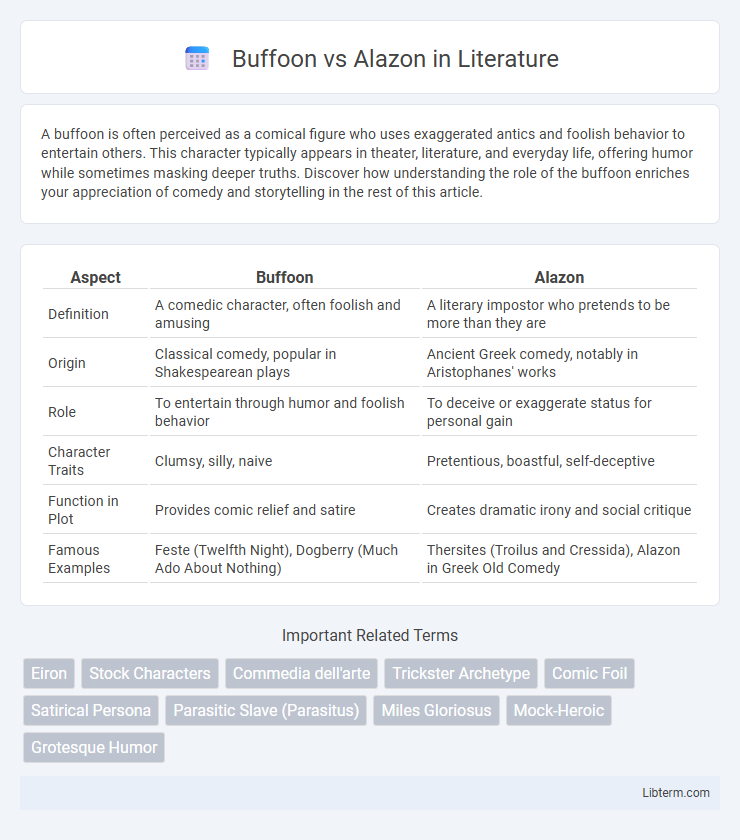A buffoon is often perceived as a comical figure who uses exaggerated antics and foolish behavior to entertain others. This character typically appears in theater, literature, and everyday life, offering humor while sometimes masking deeper truths. Discover how understanding the role of the buffoon enriches your appreciation of comedy and storytelling in the rest of this article.
Table of Comparison
| Aspect | Buffoon | Alazon |
|---|---|---|
| Definition | A comedic character, often foolish and amusing | A literary impostor who pretends to be more than they are |
| Origin | Classical comedy, popular in Shakespearean plays | Ancient Greek comedy, notably in Aristophanes' works |
| Role | To entertain through humor and foolish behavior | To deceive or exaggerate status for personal gain |
| Character Traits | Clumsy, silly, naive | Pretentious, boastful, self-deceptive |
| Function in Plot | Provides comic relief and satire | Creates dramatic irony and social critique |
| Famous Examples | Feste (Twelfth Night), Dogberry (Much Ado About Nothing) | Thersites (Troilus and Cressida), Alazon in Greek Old Comedy |
Understanding the Buffoon: Definition and Traits
The Buffoon is a comedic character distinguished by foolishness, exaggerated behavior, and a lack of self-awareness, often provoking laughter through physical humor and absurdity. Unlike the Alazon, who is characterized by arrogance and self-deception, the Buffoon's traits highlight innocence and naivety, making them a source of humor without malice. Understanding the Buffoon involves recognizing their role as a symbol of human folly, frequently used in literature and theater to critique societal norms through exaggerated silliness.
Who Is the Alazon? Key Characteristics
The Alazon is a classical comedic archetype representing the foolish impostor who overestimates their abilities and status, often displaying arrogance and delusions of grandeur. Key characteristics include excessive pride, self-deception, and attempts to outsmart others despite lacking genuine talent or wisdom. This figure contrasts with the Buffoon, who is more overtly silly and clownish, while the Alazon's folly stems from inflated self-importance and misguided ambition.
Historical Origins of Buffoon and Alazon
The historical origins of Buffoon trace back to ancient Roman and medieval European theater, where this character embodied physical comedy, foolishness, and satirical wit to entertain audiences. In contrast, the Alazon stems from classical Greek Old Comedy, representing a boastful, self-deceived figure whose exaggerated pride and arrogance drive the plot's conflict. Both archetypes highlight distinct comedic functions: the Buffoon as a creature of folly provoking laughter, and the Alazon as a hubristic impostor exposing social or personal pretensions.
Buffoon vs Alazon: Role in Classical Comedy
The Buffoon and Alazon represent contrasting character types in classical comedy, with the Buffoon embodying foolishness and humor through physical comedy and slapstick, often serving as the source of laughter without self-awareness. The Alazon, by contrast, is a swaggering impostor or braggart who falsely believes in their own superiority, driving the plot through deception and inflated self-importance. Their roles complement the comedic structure by highlighting themes of self-deception and social folly, essential in classical plays by Aristophanes and Menander.
How Buffoons Differ from Alazons in Behavior
Buffoons differ from alazons primarily in their self-awareness and intent behind their behavior; buffoons often embrace foolishness for humor without pretension, while alazons display exaggerated self-importance and deception to mask insecurity. Buffoons engage audiences through slapstick or absurdity, revealing genuine human folly, whereas alazons manipulate perceptions, creating false personas to assert superiority. The behavioral distinction lies in buffoons provoking laughter through authentic folly and alazons driving conflict through insincere posturing.
The Function of Buffoon in Literary Works
The buffoon serves as a comedic figure in literary works, often highlighting human folly through exaggerated foolishness and slapstick humor. This character contrasts with the alazon, who typically embodies self-deception and pretension, driving dramatic irony by presenting false appearances. The buffoon's primary function is to provide comic relief, undermine authority, and reveal truths by ridiculing social norms and conventions.
Alazon’s Place in Ancient and Modern Storytelling
The alazon, a stock character originating in ancient Greek comedy, embodies the boastful impostor who dramatically overestimates their own abilities or status, serving as a vital figure in both classical and contemporary narratives. This archetype's function as a source of dramatic irony and social critique persists in modern storytelling, where characters displaying exaggerated self-importance highlight human folly and the consequences of deception. The enduring presence of the alazon underscores its importance in exploring themes of identity, hubris, and the social dynamics between self-perception and reality across diverse literary and theatrical traditions.
Famous Examples: Buffoon and Alazon Characters
The buffoon character, known for exaggerated foolishness, appears in Shakespeare's Falstaff as a humorous yet flawed figure evoking laughter and satire. The alazon character, representing self-deception and arrogance, is epitomized by Moliere's Tartuffe, whose false piety and manipulation reveal societal hypocrisy. Famous examples highlight the buffoon's comedic failure contrasted with the alazon's tragic self-delusion, emphasizing their distinct roles in classical literature.
Buffoon and Alazon in Popular Culture Today
The Buffoon character, often portrayed as a comedic fool lacking self-awareness, contrasts sharply with the Alazon, who embodies arrogant self-deception and exaggerated pride in popular culture today. Buffoons appear frequently in sitcoms and variety shows, using slapstick humor and mishaps to elicit laughter, while Alazon figures are prominent in satirical works, exposing hubris and pretentiousness through exaggerated confidence. Modern media continuously revisits these archetypes to critique societal norms and highlight human folly in relatable, entertaining ways.
The Impact of Buffoon and Alazon Archetypes on Modern Humor
The Buffoon archetype, characterized by foolishness and slapstick behavior, drives modern humor through exaggerated physical comedy and self-deprecating antics, engaging audiences with lighthearted amusement. In contrast, the Alazon, embodying arrogance and deceit, fuels satirical humor by exposing pretentiousness and societal hypocrisy, often creating laughter through intellectual irony and critique. Both archetypes significantly shape contemporary comedic narratives by reflecting human flaws, enhancing relatability and social commentary in entertainment.
Buffoon Infographic

 libterm.com
libterm.com